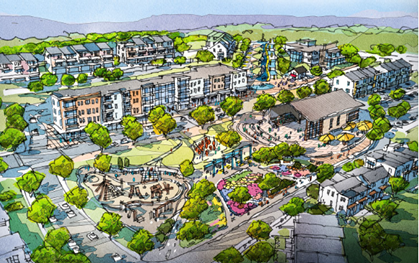As HUD’s signature place-based program, Choice Neighborhoods offers significant revitalization potential for communities of all sizes by leading to new mixed-income housing, new neighborhood amenities such as parks and grocery stores, and improved resident outcomes and opportunities. In the last decade, the program has awarded over $1 billion in grants, creating over 30,000 new mixed-income housing units in 40 cities while taking the approach of investing in Housing, People and Neighborhoods.

And the program is growing — for FY22 Choice Neighborhoods will make available $350 million in grants to communities nationwide. In fact, HUD just awarded $180 million in Implementation Grants to four cities: Omaha, NE; Durham, NC; Knoxville, TN and Tulsa, OK. In addition, the upcoming FY22 Choice Neighborhoods Implementation Grants Notice of Funding Opportunity (NOFO) will be published in the near future.
Ahead of this new opportunity for funding, we would like to bring the discussion down to the city level and highlight some of the benefits of the program, as well as how local governments can prepare for the application process.
What Past Grantees Have to Say
Choice Neighborhood grants offer a unique opportunity for revitalization at the local level due to the commitment to ensuring one-for-one replacement of target housing units, expansive partnerships and high levels of community engagement associated with the program. The effort also catalyzes tremendous public and private investment, supplemental to the grant itself.
Given the potential and great success that can come from receiving an award, a 2020 survey of past Choice Neighborhoods Planning Grantees indicated that 92 percent would recommend a planning grant to another community. Below are insights from existing grantees:
Los Angeles, CA
Choice Neighborhoods: Rancho San Pedro, Watts Rising and William Mead Homes
“Choice Neighborhoods is helpful to fill gaps particularly on housing development. It also provides valuable dollars for resident services, human capital planning and the funding for neighborhood investments is golden.” – Jenny Scanlin, Chief Development Officer, Housing Authority of the City of Los Angeles
Omaha, NE
Choice Neighborhoods: Spencer Homes and Southside Terrace
“Housing Authorities and Cities [have] important roles [in Choice Neighborhoods Grants]. PHAs have to partner and bring other resources… The City has avenues and tools like zoning and planning… Sharing the workload is important [and both] must be at the table together and on the same page.” – Joanie Poore, CEO, Omaha Housing Authority
“We really leaned into finding trusted partners in the community to participate in engagement and outreach. Be strategic at who’s doing what…good examples are to have partners in place, knowing what roles you have, and trust and respect these roles.” – Kellie Johnston Dorsey, Neighborhood Planning Manager, City of Omaha
Fort Worth, TX
Choice Neighborhood: Stop Six
“I would encourage elected officials to use this tool to reimagine some of our communities in need and start to rebuild. When you can align local, state and federal funds, you can deliver positive outcomes and ensure a better tomorrow for the people we serve.” – Mayor Pro Tem Gyna M. Bivens, Fort Worth, TX
Eligibility
The first thing that all prospective applicants need to ask themselves before they delve into the details of the application requirements is: Am I eligible for a Choice Neighborhoods grant?
There are key eligibility criteria that must be met:
- Applicant Type: Eligible applicants for Implementation Grants include public housing authorities, local governments, and tribal entities. Applicant eligibility is expanded to include nonprofits for Planning Grant applications.
- Target Housing: Eligible applicants must focus on at least one severely-distressed HUD public housing project or HUD-assisted project, such as a housing property with an existing Section 8 Housing Assistance Payment (HAP) contract.
- Neighborhood: An eligible neighborhood is an area with at least 15 percent of the residents estimated to be in poverty or have extremely low incomes based on the most recent U.S. Census data.
Note: This is a broad summary and additional eligibility requirements apply. Interested applicants should review each NOFO announcement carefully and in full.
The Application Process
Understanding The Electronic Application Process
Upon publication, the Choice Neighborhoods Grants Notice of Funding Opportunity (NOFO) can be found online at grants.gov. Here you can download both the application package and instructions, which contains official copies of the NOFO and all necessary forms.
Be sure to take the time to familiarize yourself with the Grants.gov electronic submissions system prior to submitting, and watch or join webinars that are available for assistance with the application.
Application Components
Choice Neighborhoods grants are competitive. Applications are reviewed and scored based on the criteria included in the NOFO. The Choice Neighborhoods Grant application has three main components:
- Narrative Exhibits: Narratives in the first part of the application will respond to key thresholds, rating factors, and other criteria in the NOFO.
- Attachments: These accompanying documents will also respond to rating factors,as well as threshold and mandatory documentation requirements (i.e. maps, photographs, application data forms and various certifications).
- Standard Forms: This includes the standard table of contents form, supplemental information forms, and required certifications and assurances for federal grants.
Tips for Successful Applications
- Read all NOFO materials and instructions at least three times. For rating factors, respond to every component and question for each factor, providing the specific details and information requested. Your response will be evaluated based on the specific criteria laid out in the NOFO.
- Review the application and attachments several times to avoid leaving out important information or required elements. Pay careful attention to “Threshold Eligibility Requirements” and “Other Submission Requirements” to ensure you have fully responded to and met these requirements.
- Make sure all documents are signed and dated.
Next Steps for Cities
Cities play an important role as both grantees and key partners for Choice Neighborhoods grants. Local governments provide vital neighborhood services and can help in identifying and understanding the needs of neighborhood residents and the community. Local governments can also work to engage community stakeholders, businesses and institutions, serving as a critical link for troubled neighborhoods. Lastly, the regulatory powers of local governments can be used to encourage locally-driven revitalization strategies and goals of the Choice Neighborhoods program.
Visit the website and explore resources such as NOFO webinars, promising practice guides and links to grantee websites as you develop your Choice Neighborhoods project.
About This Blog Series:
Choice Neighborhoods is a HUD grant program that provides significant investment – grants of up to $50 million – to cites, public housing authorities, and tribal entities for comprehensive neighborhood revitalization. This is the second in a series of posts highlighting Choice Neighborhoods and why local governments should pursue these HUD grants. This is part two of a three-part series. Read part one here.
About the Author
Luci Blackburn is the Director of the Choice Neighborhoods program in the Office of Public Housing Investments at the Department of Housing & Urban Development.









